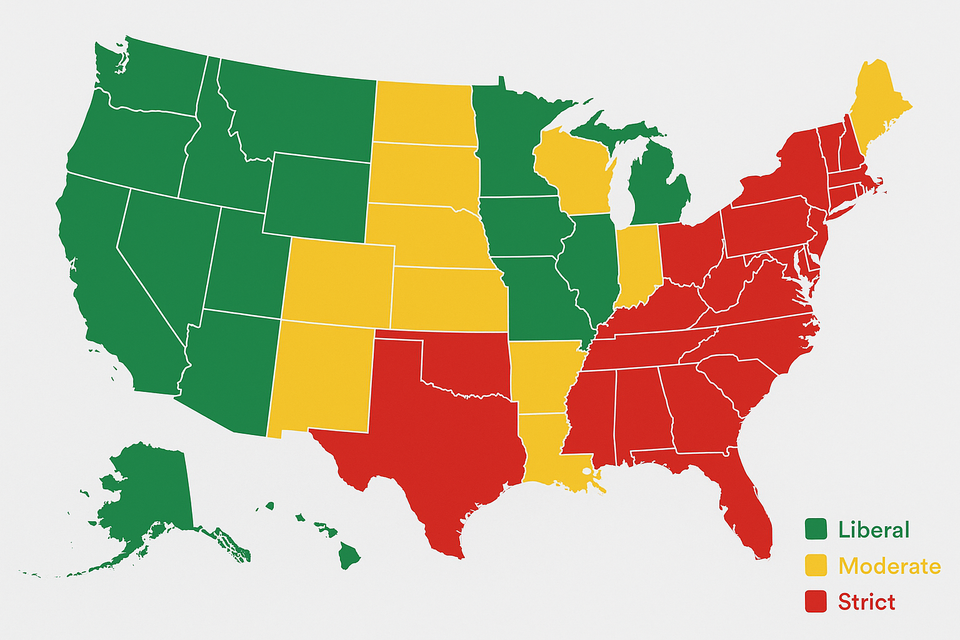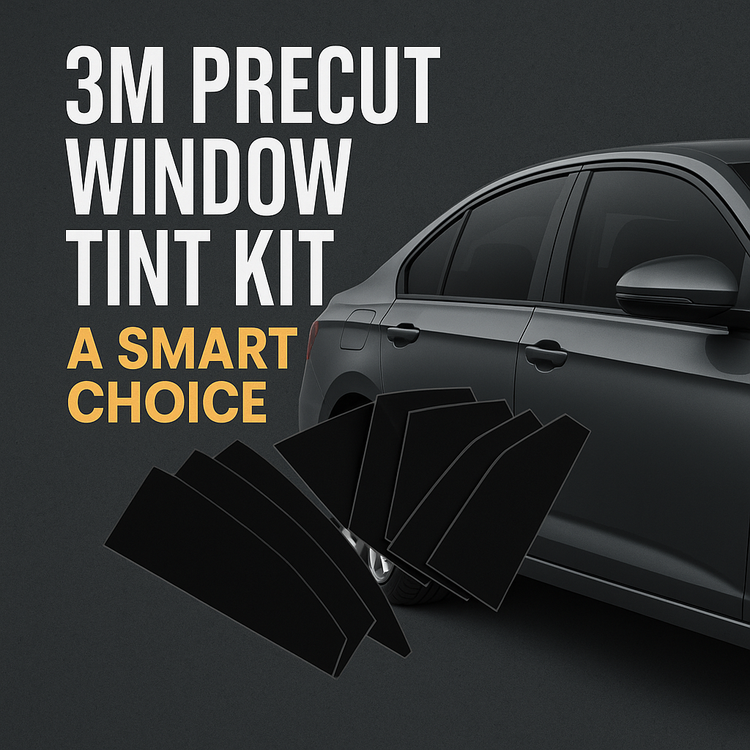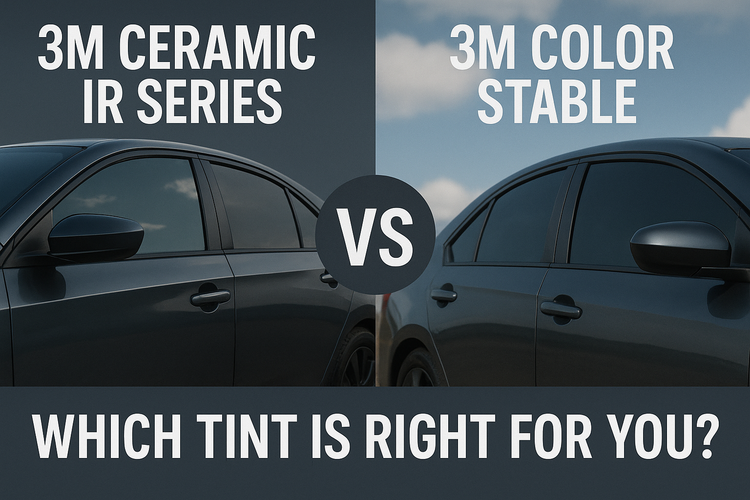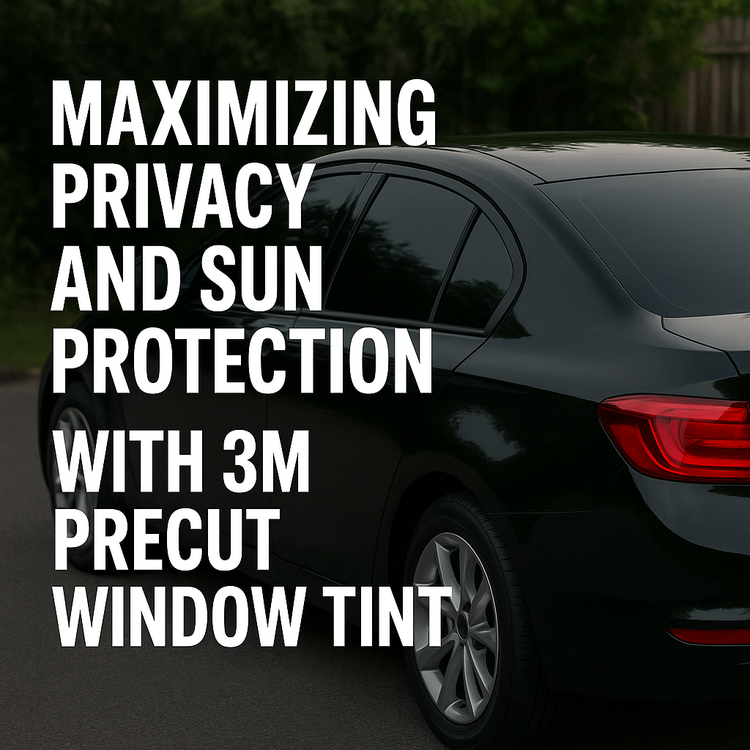Window Tint Laws by State: 2025 Legal Guide

You've invested in quality tint. Then you get pulled over, and an officer says your tint is illegal.
Fines, inspection failures, and expensive removal suddenly turn a straightforward upgrade into a costly mistake.
State tint laws vary dramatically. This guide shows you how to maximize protection while staying completely legal.
Quick Reference
VLT basics:
- VLT = Visible Light Transmission (% of light passing through)
- Lower VLT = Darker tint (20% is darker than 50%)
- Front windows face strictest rules
Most restrictive: NY, PA, NJ, CA (70% VLT or no front tint) Most permissive: NH, MI, VT (no restrictions)
Understanding VLT
VLT = percentage of visible light that passes through tint
70% VLT: Very light, barely noticeable 50% VLT: Light tint, subtle 35% VLT: Medium darkness (most popular) 20% VLT: Dark tint, significant privacy 5% VLT: "Limo tint," extremely dark
Key: Lower numbers = darker tint. 20% VLT blocks 80% of visible light.
State Legal Limits: Quick Reference
By Strictness Level
Regional Breakdown
NORTHEAST
Strictest:
- New York: 70% front, 70% rear
- Pennsylvania: 70% all windows
- New Jersey: No aftermarket front tint allowed
Moderate:
- Connecticut: 35% all windows
- Maine: 35% front, any rear
- Massachusetts: 35% all windows
Most Permissive:
- New Hampshire: No restrictions
- Vermont: No restrictions
SOUTHEAST
Common Standard (32-35%):
- Alabama, Georgia, North Carolina, South Carolina, Tennessee, Virginia
More Permissive:
- Florida: 28% front, 15% rear
- Mississippi: 28% all windows
- Louisiana: 40% front, 12% rear window
MIDWEST
Restrictive:
- Iowa: 70% front, any rear
- Minnesota: 50% all windows
Moderate:
- Indiana, Wisconsin, Kansas, Ohio, Illinois: 30-50% front
Permissive:
- Michigan: No restrictions
- Missouri: 35% front, any rear
SOUTHWEST
Moderate:
- Arizona: 33% front, any rear
- Nevada: 35% front, any rear
- Colorado: 27% all windows
Permissive:
- New Mexico: 20% all windows
- Texas: 25% front, any rear
WEST
Restrictive:
- California: 70% front, any rear (heavily enforced)
- Alaska: 70% front, 40% rear
Moderate:
- Oregon: 35% all windows
- Washington: 24% all windows
- Hawaii: 35% all windows
Permissive:
- Montana: 24% front, 14% rear
Additional Restrictions
Reflection Limits
Many states restrict reflectivity:
- "No more than 20% reflective"
- "No metallic or mirrored appearance"
Why it matters: Metallic films can exceed limits even if darkness is legal.
Color Restrictions
Commonly prohibited:
- Red: 20+ states (resembles emergency vehicles)
- Amber/Yellow: 15+ states
- Blue: California and others
Modern ceramic films are neutral gray/charcoal, avoiding issues.
Windshield Rules
Nearly all states allow:
- Above AS-1 line (4-6 inches from top)
- Non-reflective only
Use this: Dark strip reduces glare significantly, completely legal.
Medical Exemptions
Many states offer exemptions for medical conditions.
Qualifying Conditions
- Photophobia (extreme light sensitivity)
- Lupus and UV-sensitive diseases
- Skin cancer/precancerous conditions
- Certain eye conditions
- Photosensitivity medications
Process
- Written prescription from physician
- Specific VLT recommendation
- Medical diagnosis/justification
- State application
- Annual/biennial renewal
Limitations:
- Don't transfer to new vehicles automatically
- Not recognized in other states
- Law enforcement may request verification
Enforcement & Penalties
How Officers Measure
- Visual assessment (subjective)
- Tint meter (definitive electronic measurement)
- Window roll-down test
Most citations occur during stops for other violations—tint becomes additional charge.
Common Penalties
First offense:
- $50-$200 fine
- Mandatory correction
- "Fix-it ticket"
Repeat violations:
- Escalating fines ($200-$500+)
- Equipment violations affecting insurance
- Inspection failures
Enforcement variation:
- Strict: CA, NY, NJ (active enforcement)
- Moderate: Most states (cite during other stops)
- Minimal: NH, VT, MI (rarely enforce)
Staying Legal While Maximizing Protection
Strategy 1: Go Darker in Rear
Front windows = strictest rules. Rear often much more permissive.
Example (Texas):
- Front: 25% minimum
- Rear: Any darkness
Approach: 25-35% front (compliant), 5-15% rear (max privacy)
Strategy 2: Choose Ceramic Over Dark Dyed
3M Ceramic IR at 40% VLT (light, legal everywhere) rejects more heat than dyed at 20% VLT (dark, illegal many places).
In restrictive states, ceramic delivers superior performance at legal darkness.
Strategy 3: Maximize Windshield Strip
Most states allow 4-6 inches from top:
- Reduces glare
- Protects dashboard
- Improves comfort
- Completely legal
Use full allowable area with darkest legal tint.
Strategy 4: Multi-State Travel
If crossing state lines regularly, comply with most restrictive state visited.
Example: Nevada resident (35% legal) visiting California (70% required):
- Option A: Install 70% (compliant everywhere)
- Option B: Install 35% (accept CA citation risk)
Most choose peace of mind over darker tint.
Choosing Compliant Tint
Step 1: Verify Requirements
Identify for your state:
- Front side window minimum VLT
- Rear window minimum VLT
- Reflection restrictions
- Color prohibitions
- Windshield allowances
Step 2: Prioritize
Maximum legal darkness:
- Front: Darkest legal VLT
- Rear: Often much darker allowed
Heat rejection priority:
- Ceramic with high IR rejection
- Allows lighter VLT, superior performance
Step 3: Document Compliance
Keep records:
- Receipt with VLT specs
- Medical exemption (if applicable)
- Installation details
The Compliance Decision
Ask yourself:
- What are my state's exact requirements?
- Do I cross state lines regularly?
- What's my risk tolerance?
- Do I qualify for medical exemption?
- What's my priority: privacy, heat, or strict legality?
The Bottom Line
Citations are expensive. Re-tinting is wasteful. Compliance eliminates stress.
Smart approach:
- Know your state's rules
- Choose darkest legal front tint
- Maximize rear protection
- Invest in ceramic (performance at legal VLT)
- Document compliance
- Consider exemptions if qualified
With precise knowledge, you can install tint delivering maximum protection—without risking citations.
Tint with confidence: State-compliant 3M kits → | Contact compliance specialists →
Author: Compiled from official DMV sources • Updated quarterly • Last update: January 2025



